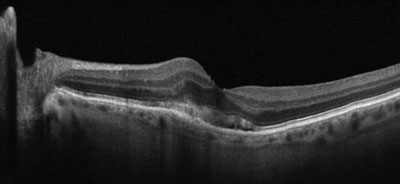 |
|
Choroidal thinning is more pronounced in advanced chronic kidney disease. Photo: Carolyn E. Majcher, OD. Click image to enlarge. |
Retinal and choroidal changes have been observed in patients with chronic kidney disease. Fundus examination can be a valuable tool for visualizing the chorioretinal microvasculature that may be affected in this disease. Researchers in Egypt believe that noninvasive OCT for imaging the retina and choroid could also identify these changes. Their recent study determined that chorioretinal thinning in chronic kidney disease was associated with a lower estimated glomerular filtration rate, a higher serum C-reactive protein concentration and greater proteinuria. They believe that further studies with a larger scale could detect whether these eye changes reflect the natural history of chronic kidney disease.
A cross-sectional study was conducted on 144 eyes of 72 patients divided into three groups according to the stage of chronic kidney disease: stages one and two with glomerular filtration rate > 60mL/min/1.73m2, stage three with filtration rates 30mL/min/1.73m2 to 59mL/min/1.73m2 and stages four and five with estimated rates < 29mL/min/1.73m2.
The study found that a thinner retina and choroid were associated with chronic kidney disease stage three with even more thinning in stages four and five. There was no association found between retinal and choroidal thickness and hypertension, as well as no difference in retinal nerve fiber layer thickness between the three groups. Also, associations between C-reactive protein concentration and albuminuria were inversely correlated with choroidal thickness in chronic kidney disease and were independent predictors of thickness. The researchers believe these findings may be explained by the role of inflammation in the development of both vascular and renal disease.
This thinning could reflect a direct microvascular insult. As the vessels of the choroid supply the outer retinal layers and the retinal pigment epithelium, it is possible that retinal abnormalities may occur as a result of choroidal pathology. The choroid plays a vital role in retinal function, as it nourishes the outer half of the retina. Abnormal choroidal circulation can lead to retinal photoreceptor dysfunction and death.
“These findings support the potential use of chorioretinal thickness profile as a biomarker for chronic kidney disease progression,” the authors concluded in their paper.
Basiony AI, Atta SN, Dewidar NM, Zaky AG. Association of chorioretinal thickness with chronic kidney disease. BMC Ophthalmol. February 9, 2023. [Epub ahead of print]. |

